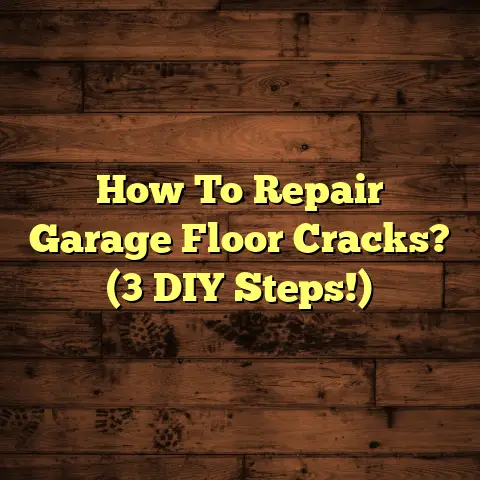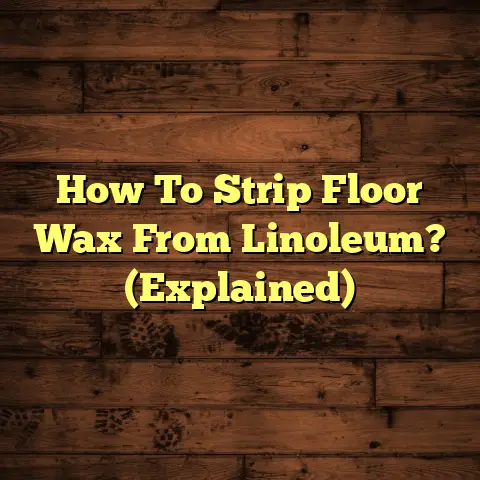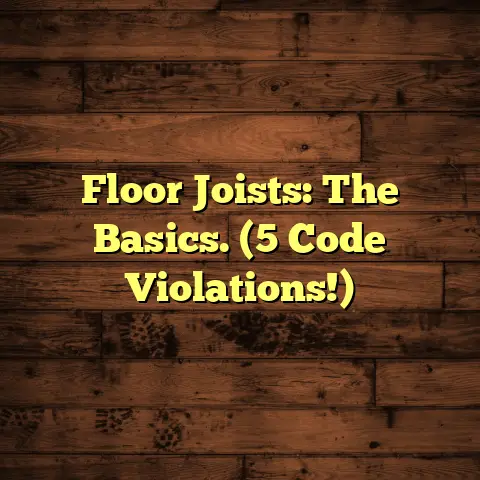Remove Scuffs From Vinyl: Easy Guide (6 Quick Fixes!)
Vinyl is fantastic – it’s durable, stylish, and
easy to install.
But those pesky scuffs?
They can make even the newest vinyl look old
and worn.
But don’t worry, I’m here to help!
In this
guide, I’ll share my top 6 quick fixes for
removing scuffs from vinyl flooring, so you can
keep your home looking its best.
Plus, we’ll dive into why maintaining your floors is so important, not just for looks, but for creating a quieter, more peaceful home.
The Importance of Noise Reduction
in Flooring
Have you ever noticed how some rooms just
feel calmer than others?
A lot of that has
to do with sound.
Hard surfaces like tile and
hardwood can bounce sound around, creating
echoes and a sense of chaos.
That’s where vinyl flooring comes in!
Vinyl,
especially thicker options like Luxury Vinyl
Tile (LVT), naturally dampens sound better
than many other hard flooring choices.
Think about it – a softer surface absorbs
sound waves instead of reflecting them.
This
means less echo, less noise transfer between
floors, and a generally more serene atmosphere.
Now, imagine that serene atmosphere marred by
unsightly scuffs.
It’s like a scratch on a
record – it disrupts the smooth experience.
Keeping your vinyl floors clean and scuff-free isn’t just about aesthetics; it’s about preserving that quiet, comfortable environment you’ve worked hard to create.
A well-maintained floor helps minimize noise
echoes, leading to a more peaceful home.
Trust
me, your ears (and your sanity!) will thank you.
**Section 1: Understanding
Vinyl Flooring**
Okay, let’s get down to basics.
Before we start
erasing scuffs, it’s important to understand
what we’re working with.
1.1 What is Vinyl Flooring?
Vinyl flooring isn’t just one thing.
It’s a
whole family of products, each with its own
unique characteristics.
The most common types you’ll find are:
Vinyl Sheets: These come in large rolls and are great for covering entire rooms with a seamless surface.
They’re typically the most budget-friendly option.Luxury Vinyl Tile (LVT): LVT is designed to mimic the look of natural materials like wood or stone.
It comes in individual tiles or planks, offering more design flexibility.-
Vinyl Composition Tile (VCT): A more commercial-grade option, VCT is known for its durability and affordability.
Regardless of the type, all vinyl flooring shares some key benefits:
Waterproof: This is a big one!
Vinyl is highly resistant to water damage, making it perfect for kitchens, bathrooms, and laundry rooms.-
Easy Installation: Many vinyl products feature click-lock systems or peel-and-stick backing, making DIY installation a breeze.
-
Variety of Designs: From realistic wood grain to vibrant patterns, vinyl flooring offers endless design possibilities.
I’ve personally installed countless vinyl floors, and I’m always impressed by the advancements in realism and durability.
Did you know that the global vinyl flooring
market was valued at over $35 billion in 2023?
That just shows how popular and versatile this
flooring option is!
(Source: Grand View Research)
**1.2 Common Issues with
Vinyl Flooring**
While vinyl is tough, it’s not invincible. Here are some common problems homeowners face:
-
Scratches: Sharp objects, like furniture legs or dropped items, can easily scratch the surface.
-
Dents: Heavy furniture or appliances can leave dents, especially on softer vinyl options.
-
Scuffs: These are those annoying marks left by shoes, pet claws, or anything that rubs against the floor.
Scuffs happen when something rubs against the vinyl surface, leaving behind a mark of transferred material or slight abrasion.
Think of it like this: the sole of your shoe might leave a bit of rubber behind, or a piece of dirt might scratch the surface as you walk.
It’s important to address scuffs promptly for a few reasons:
-
Appearance: Scuffs make your floor look dirty and worn, even if it’s otherwise clean.
-
Damage: Over time, scuffs can lead to deeper scratches or wear down the protective layer of the vinyl.
-
Maintenance: The longer you wait, the harder it can be to remove scuffs.
Trust me, a little preventative maintenance goes a long way in keeping your vinyl floors looking their best.
**Section 2: The Impact of
Scuffs on Vinyl Flooring**
Let’s dig a little deeper into why those scuffs are more than just a minor annoyance.
2.1 Aesthetic Concerns
I’ve walked into homes where the floors are
the first thing that catches my eye – and not
in a good way.
Scuffed vinyl flooring can
instantly make a home look dated and neglected.
Think about it: you’ve carefully chosen your
furniture, paint colors, and décor to create a
certain aesthetic.
Scuffs disrupt that harmony,
making the space feel less polished and inviting.
Maintaining a clean and scuff-free floor is
essential for enhancing the visual appeal of
your home.
It shows that you care about your
space and take pride in its appearance.
A pristine floor reflects light better, making
the room feel brighter and more spacious.
Plus,
it creates a positive first impression for
guests.
I’ve seen firsthand how a simple floor cleaning
can transform a room.
It’s amazing what a
difference it makes!
2.2 Longevity and Maintenance
Scuffs aren’t just cosmetic issues; they can actually shorten the lifespan of your vinyl flooring.
When left unaddressed, scuffs can accumulate
dirt and grime, which can further abrade the
surface.
This can lead to deeper scratches and
wear down the protective layer of the vinyl,
making it more susceptible to damage.
Think of it like a small chip in your car’s
windshield.
If you don’t fix it, it can spread
into a large crack.
Regular maintenance and prompt attention to minor issues are crucial for extending the life of your vinyl flooring.
This includes:
-
Regular sweeping or vacuuming: To remove dirt and debris that can cause scuffs.
-
Promptly cleaning spills: To prevent stains and damage.
-
Using the right cleaning products: Avoid harsh chemicals that can damage the vinyl.
-
Addressing scuffs as soon as you notice them: To prevent them from becoming more severe.
I always tell my clients that a little bit of effort goes a long way in preserving the beauty and longevity of their vinyl floors.
**Section 3: 6 Quick Fixes for
Removing Scuffs from Vinyl Flooring**
Alright, let’s get to the good stuff!
Here are
my top 6 quick fixes for removing scuffs from
vinyl flooring, using common household items and
techniques.
Fix #1: Soap and Water Solution
This is my go-to method for tackling everyday scuffs. It’s simple, gentle, and effective.
-
What you’ll need:
- Warm water
- Mild dish soap (like Dawn)
- Clean microfiber cloth
- Bucket
Instructions:
-
Fill the bucket with warm water and add a small amount of dish soap (about a tablespoon per gallon of water).
-
Dip the microfiber cloth into the soapy water, making sure it’s damp but not soaking wet.
-
Gently scrub the scuffed area in a circular motion.
Avoid applying too much pressure, as this can damage the vinyl. -
Rinse the area with clean water and dry with a fresh microfiber cloth.
-
I prefer microfiber cloths because they’re gentle on the vinyl and won’t leave behind any lint or residue.
Fix #2: Baking Soda Paste
For more stubborn scuffs, baking soda can work
wonders.
It’s a mild abrasive that can help
lift the scuff marks without scratching the vinyl.
-
What you’ll need:
- Baking soda
- Water
- Clean microfiber cloth
-
Instructions:
-
Make a paste by mixing baking soda with a small amount of water until it forms a thick consistency.
-
Apply the paste to the scuffed area and let it sit for a few minutes (no more than 5).
-
Gently scrub the area with a microfiber cloth in a circular motion.
-
Rinse thoroughly with clean water and dry with a fresh cloth.
-
Be sure to test the baking soda paste in an inconspicuous area first to ensure it doesn’t damage the vinyl.
Fix #3: Vinegar and Water Mixture
Vinegar is a natural cleaner and disinfectant that can be used to remove scuffs and brighten vinyl floors.
-
What you’ll need:
- White vinegar
- Water
- Spray bottle
- Clean microfiber cloth
-
Instructions:
-
Mix equal parts white vinegar and water in a spray bottle.
-
Spray the solution onto the scuffed area.
-
Let it sit for a few minutes.
-
Wipe the area with a clean microfiber cloth.
-
Rinse with clean water and dry.
-
Vinegar can have a strong odor, so make sure to
ventilate the room well while you’re cleaning.
Also, avoid using vinegar on no-wax vinyl
floors, as it can dull the finish over time.
Fix #4: Rubbing Alcohol
For tough scuffs that just won’t budge, rubbing
alcohol can be a lifesaver.
It’s a powerful
solvent that can dissolve the material causing
the scuff.
-
What you’ll need:
- Rubbing alcohol (isopropyl alcohol)
- Cotton balls or clean cloth
-
Instructions:
-
Dampen a cotton ball or clean cloth with rubbing alcohol.
-
Gently rub the scuffed area.
-
Be careful not to apply too much pressure or saturate the vinyl, as this can damage it.
-
Wipe away any excess alcohol with a clean, damp cloth.
-
Dry the area thoroughly.
-
Always test rubbing alcohol in an inconspicuous area first to ensure it doesn’t discolor or damage the vinyl.
Fix #5: Commercial Vinyl Floor Cleaners
If you prefer a ready-made solution, there are many excellent commercial vinyl floor cleaners available.
-
What you’ll need:
- Commercial vinyl floor cleaner (follow manufacturer’s instructions)
- Mop or microfiber cloth
Instructions:
-
Choose a cleaner specifically designed for vinyl flooring.
Avoid using abrasive cleaners or those containing harsh chemicals. -
Follow the manufacturer’s instructions for diluting and applying the cleaner.
-
Mop or wipe the floor with the cleaner, paying special attention to scuffed areas.
-
Rinse with clean water and dry.
-
I recommend reading online reviews and checking with the flooring manufacturer to find the best cleaner for your specific type of vinyl.
Fix #6: Magic Erasers
Magic erasers are those melamine foam sponges
that seem to work wonders on just about
anything.
They can also be effective at
removing scuffs from vinyl flooring.
-
What you’ll need:
- Magic eraser
- Water
-
Instructions:
-
Dampen the magic eraser with water.
-
Gently rub the scuffed area with the magic eraser.
-
Be careful not to apply too much pressure, as magic erasers can be abrasive and potentially damage the vinyl.
-
Wipe away any residue with a clean, damp cloth.
-
Dry the area thoroughly.
-
I’ve found that magic erasers work best on light
scuffs.
For more stubborn marks, you may need
to use one of the other methods.
**Section 4: Preventive Measures to
Avoid Future Scuffs**
Okay, you’ve successfully removed the scuffs from
your vinyl floor.
Now, let’s talk about how to
prevent them from coming back!
4.1 Use Protective Pads
This is the easiest and most effective way to prevent scuffs from furniture.
Felt Pads: Attach felt pads to the legs of all your furniture, especially chairs, tables, and sofas.
These pads create a barrier between the furniture and the floor, preventing scratches and scuffs.-
Furniture Coasters: Use furniture coasters under heavy items like bookshelves or cabinets to distribute the weight and prevent dents.
I always recommend using high-quality felt pads
that are specifically designed for hard floors.
Cheap pads tend to wear out quickly and can
leave behind a sticky residue.
4.2 Regular Cleaning Routine
A regular cleaning routine is essential for maintaining the beauty and longevity of your vinyl floors.
-
Sweep or Vacuum Regularly: Sweep or vacuum your floors at least once a week to remove dirt, dust, and debris that can cause scuffs.
-
Mop as Needed: Mop your floors with a mild soap and water solution or a commercial vinyl floor cleaner as needed to remove stains and spills.
-
Use Doormats: Place doormats at all entrances to trap dirt and debris before they can be tracked onto your floors.
I recommend creating a cleaning schedule and
sticking to it.
This will help prevent the
buildup of dirt and grime and make it easier to
keep your floors looking their best.
4.3 Choose Appropriate Footwear
Believe it or not, the shoes you wear indoors can have a big impact on the condition of your vinyl floors.
Soft-Soled Shoes: Encourage family members and guests to wear soft-soled shoes or slippers indoors.
Hard-soled shoes, especially those with heels, can easily scuff and scratch vinyl floors.-
No Outdoor Shoes: Establish a “no outdoor shoes” policy to prevent dirt and debris from being tracked onto your floors.
I know it can be tough to enforce a “no shoes” policy, but it’s one of the best things you can do to protect your vinyl floors.
**Conclusion: Maintaining Pristine
Vinyl Flooring**
So, there you have it!
My top 6 quick fixes for
removing scuffs from vinyl flooring, along with
some essential preventative measures.
Remember, keeping your vinyl floors looking
their best is about more than just aesthetics.
It’s about creating a clean, comfortable, and
quiet home environment.
By addressing scuffs promptly and maintaining a regular cleaning routine, you can extend the life of your vinyl flooring and enjoy its beauty for years to come.
I encourage you to implement these tips and
tricks in your own home.
You’ll be amazed at
the difference it makes!
A clean, well-maintained floor not only enhances the aesthetic appeal of your home but also contributes to a quieter, more enjoyable living environment.
Now, go forth and conquer those scuffs!
Your
floors (and your ears) will thank you.





